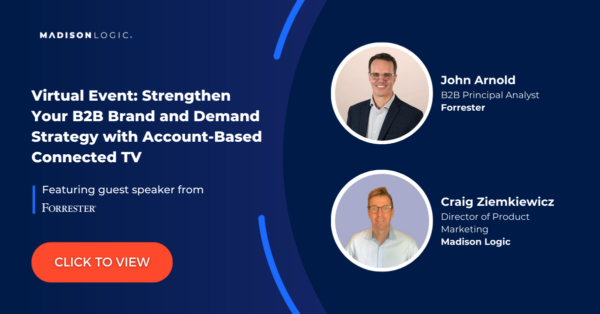
Why You Need a Unified Brand-to-Demand Strategy

B2B marketing is not just about selling a product or service. It’s about building positive brand awareness and strong relationships throughout the entire customer lifecycle.
We face a changing B2B buying landscape with longer sales cycles and larger buying committees made up of increasingly independent decision-makers. Gartner research finds that 70% of the buying journey is complete before a buying group reaches out to a provider. Moreover, only 17% of the purchase process involves a conversation with a provider, and your sales team may only get 5-6% of a buying group’s time.
With this limited direct interaction from sales, it’s up to the marketing team to tell the brand story and prove to the buying committee members that you’re a provider they can trust through your content and messaging. You can’t do this at the very end of the customer journey—you need to catch their attention and increase awareness before they begin the research process with a unified brand-to-demand strategy.
What Happens When You Focus Too Much on Demand
Many marketers recognize the power of a brand-building strategy, but demand activities still dominate their budgets and focus. Most organizations want to drive immediate growth, and brand efforts take longer and are harder to measure and demonstrate ROI. But with Forrester research finding that 67% of B2B marketers say accounts are taking longer to commit to purchases than last year, a holistic and balanced approach to your brand and demand activities ensures that your marketing team creates enough awareness to fulfill demand capture and position your company for long-term growth.
Here’s what happens when you focus too much on demand and not enough on building brand awareness:
Buyers Won’t Include You on Their Day One List
Joint research from Google and Bain & Company finds that a majority of buyers across various verticals have an initial consideration list and ultimately select a vendor from that day one list. To land on that day one consideration list, you need to build brand recognition and trust with buyers before they even start looking through a brand-building strategy, and then balance those efforts with demand capture activities to close those deals and win a lifetime customer.
Less Efficient Sales Team Conversations with Buyers
With the limited time that your sales team has with an account, it’s important that sales conversations focus on the finer aspects of your product through a demo or building out a request for a proposal in the final decision stage. More focus on brand-building efforts establishes more familiarity and awareness of the solution. This allows your sales team to better connect with key decision-maker and convert conversations into opportunities and wins.
You Overspend on Demand Capture Efforts
Putting all your efforts towards demand capture and not investing in demand creation limits your long-term growth and success. By neglecting demand creation, you risk exhausting your resources on a limited pool of in-market buyers and missing potential accounts who are either unaware of their problems or not actively seeking solutions. And while many marketers recognize the benefits of strong brand-building efforts, demand generation still dominates. Research shows that 1 in 3 marketers state that 33% of budget holders are skeptical of brand marketing driving growth, so they increase focus on the KPIs that demand touches and leave brand-building to chance.
You’re Not Cultivating Long-Term Relationships
Closing deals is great, but not focusing on sustainable, long-term growth with linked brand-to-demand is a big mistake. Building a strong relationship with customers helps you retain them and guarantee long-term revenue. It also opens the doors to cross-sell and upsell opportunities that can be used to deepen an account’s investment. Transitioning from the idea of buying customers to earning customers creates an environment that places emphasis on your brand reputation and instilling trust.
What Happens When You Over Index on Brand Building
The pendulum swings both ways. Those who focus too much on brand building often miss their goals as well. It’s important to balance your brand and demand activities to increase awareness, drive more demand, and ultimately win over the members of the entire buying group.
Keep in mind that not everyone on the buying committee feels the same way about your brand at the same time. As members of the buying committee recognize their needs and search for solutions, they develop attitudes and engage in behaviors that create different levels of bias toward brands and their solutions. When you focus too much of your efforts on increasing brand awareness and not on demand generation, buyers will know and love your brand but get stuck in the pipeline because they don’t see the intrinsic value your solution brings to their problem. You need demand generation to create a sense of urgency to solve their problem and to motivate them to choose you to fix it.
Balancing Brand-to-Demand with a Full-Funnel ABM Strategy
Connecting with buyers through problem-awareness content creates brand affinity and positions you as a voice of knowledge and a source they can trust when they’re ready to seek a solution. Put simply, demand creation is “getting people to consider a solution,” and demand capture is “getting people to choose you as their solution.” With 56% of tech buyers saying that they prefer to work with established brands, having that brand familiarity and trust isn’t just nice to have—it’s critical to closing the deal. Implementing a balanced brand-to-demand approach with your data-driven account-based strategy enables you to establish awareness and deliver a customer experience that converts. Here’s how to do it:
Leverage Data to Identify Early-Stage Accounts and Create Personalized Content and Messaging
When it comes to brand-building, data is key to not only understanding which accounts are moving in-market for a solution, but also identifying the buying committee members within these accounts who will research and engage with relevant content and messaging.
While your first-party data provides key insights and characteristics of in-market accounts, the level of intelligence required to identify these early-stage accounts requires access to historical performance, technographic, and intent data to identify those with the highest propensity to purchase.
Once you’ve identified which accounts to target with a brand-building campaign, use this intelligence to create detailed buyer personas that encompass the specific pain points and needs to build and guide your brand awareness content strategy. Understanding your audience holistically helps you decide which content best resonates with them to personalize their experience.
One way to do this is by leveraging historical engagement data to identify what previous buyers searched for and what content they engaged with. Use this insight to work backwards to create content and messaging that acts like breadcrumbs that leads early-stage accounts to realize that they have a problem and makes them aware of you as a solution.
Activate a Multi-Channel Campaign Strategy That Delivers Personalized Experiences At Every Stage of the Sales Cycle
An effective brand to demand strategy enables you to get in front of buyers before they initiate their buying process and continue to build trust as they inform, consider, and evaluate their options. A unified, multi-channel approach is the only way to reach these buyers where they already are and surround them with consistent content and messaging that builds brand awareness, trust, and keep you top-of-mind when they’re ready to buy.
An emerging and effective channel used to reach key decision-makers in early-stage accounts is Connected TV (TV). When integrated into an always-on awareness campaign with other channels in a unified multi-channel approach, CTV—which includes smart TVs and other devices that stream video content outside of cable, satellite, and linear channels—accelerates the buying journey from awareness to demand conversion by reaching accounts faster with multiple touch points. This access to buying committee members in the early phase of the decision-making process is key to driving higher brand recollection when they’re making their day one list.
Interested in learning more? Check-out our virtual event on how to strengthen your B2B brand and demand strategy with account-based Connected TV:
Measure Campaign Performance for Optimization in Real-time
Understanding how early-stage accounts interact and engage with content is crucial for measuring your brand-building activities. Uncovering each account’s most effective channels, content, and advertising allows you to take a data-driven approach to campaign optimization to improve the ROI of your brand to demand efforts.
Keep an eye on metrics such as website visits, page views, time spent, content downloads, webinar attendance, and social media interactions specific to the target accounts. Analyze this data to identify patterns and trends that indicate increasing or decreasing engagement as well as what topics and messages are resonating the most.
Make sure to measure the conversion rate of target accounts from one stage of the buyer’s journey to the next. For instance, track how many accounts move from initial awareness to consideration and conversion. Account movement and conversion measured through marketing automation tools, customer relationship management (CRM) systems or other analytics platforms provide a clearer picture of account progression through the sales funnel and identify areas for optimization.
Lastly, conduct surveys and collect feedback from the targeted accounts to gauge their perception of marketing efforts. Use these to assess their level of satisfaction, brand perception, and likelihood to recommend a product or service. This qualitative data provides valuable insights into the success of your brand to demand initiatives.
Implement a Unified Brand-to-Demand Strategy That Converts Accounts Faster
Marketers have traditionally been forced to make hard tradeoffs between their brand and demand activities. In most cases, brand-building efforts typically lose out to demand as marketers focus on short-term initiatives to fill the sales pipeline and generate revenue. The truth is, if you’re not capturing the attention of these buyers with your brand before they know they have a problem to fix, you’re already losing the opportunity.
Luckily, ABM is purpose-built for creating that strong brand experience and maintaining it all the way through the funnel. With a unified brand-to-demand strategy focused on building relationships with customers before they’re ready to buy, you can deliver a consistent personalized experience that increases awareness and fuels pipeline growth and revenue.


